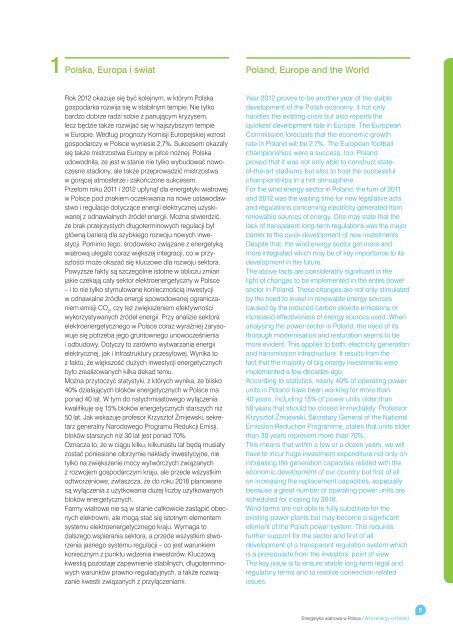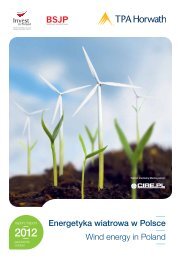Energetyka wiatrowa w Polsce Wind energy in Poland - TPA Horwath
Energetyka wiatrowa w Polsce Wind energy in Poland - TPA Horwath
Energetyka wiatrowa w Polsce Wind energy in Poland - TPA Horwath
You also want an ePaper? Increase the reach of your titles
YUMPU automatically turns print PDFs into web optimized ePapers that Google loves.
1<br />
Polska, Europa i świat <strong>Poland</strong>, Europe and the World<br />
Rok 2012 okazuje się być kolejnym, w którym Polska<br />
gospodarka rozwija się w stabilnym tempie. Nie tylko<br />
bardzo dobrze radzi sobie z panującym kryzysem,<br />
lecz będzie także rozwijać się w najszybszym tempie<br />
w Europie. Według prognozy Komisji Europejskiej wzrost<br />
gospodarczy w <strong>Polsce</strong> wyniesie 2,7%. Sukcesem okazały<br />
się także mistrzostwa Europy w piłce nożnej. Polska<br />
udowodniła, ze jest w stanie nie tylko wybudować nowoczesne<br />
stadiony, ale także przeprowadzić mistrzostwa<br />
w gorącej atmosferze i zakończone sukcesem.<br />
Przełom roku 2011 i 2012 upłynął dla energetyki wiatrowej<br />
w <strong>Polsce</strong> pod znakiem oczekiwania na nowe ustawodawstwo<br />
i regulacje dotyczące energii elektrycznej uzyskiwanej<br />
z odnawialnych źródeł energii. Można stwierdzić,<br />
że brak przejrzystych długoterm<strong>in</strong>owych regulacji był<br />
główną barierą dla szybkiego rozwoju nowych <strong>in</strong>westycji.<br />
Pomimo tego, środowisko związane z energetyką<br />
wiatrową ulegało coraz większej <strong>in</strong>tegracji, co w przyszłości<br />
może okazać się kluczowe dla rozwoju sektora.<br />
Powyższe fakty są szczególnie istotne w obliczu zmian<br />
jakie czekają cały sektor elektroenergetyczny w <strong>Polsce</strong><br />
– i to nie tylko stymulowane koniecznością <strong>in</strong>westycji<br />
w odnawialne źródła energii spowodowanej ograniczaniem<br />
emisji CO 2 , czy też zwiększeniem efektywności<br />
wykorzystywanych źródeł energii. Przy analizie sektora<br />
elektroenergetycznego w <strong>Polsce</strong> coraz wyraźniej zarysowuje<br />
się potrzeba jego gruntownego unowocześnienia<br />
i odbudowy. Dotyczy to zarówno wytwarzania energii<br />
elektrycznej, jak i <strong>in</strong>frastruktury przesyłowej. Wynika to<br />
z faktu, że większość dużych <strong>in</strong>westycji energetycznych<br />
było zrealizowanych kilka dekad temu.<br />
Można przytoczyć statystyki, z których wynika, że blisko<br />
40% działających bloków energetycznych w <strong>Polsce</strong> ma<br />
ponad 40 lat. W tym do natychmiastowego wyłączenia<br />
kwalifikuje się 15% bloków energetycznych starszych niż<br />
50 lat. Jak wskazuje profesor Krzysztof Żmijewski, sekretarz<br />
generalny Narodowego Programu Redukcji Emisji,<br />
bloków starszych niż 30 lat jest ponad 70%.<br />
Oznacza to, że w ciągu kilku, kilkunastu lat będą musiały<br />
zostać poniesione olbrzymie nakłady <strong>in</strong>westycyjne, nie<br />
tylko na zwiększenie mocy wytwórczych związanych<br />
z rozwojem gospodarczym kraju, ale przede wszystkim<br />
odtworzeniowe, zwłaszcza, że do roku 2018 planowane<br />
są wyłączenia z użytkowania dużej liczby użytkowanych<br />
bloków energetycznych.<br />
Farmy wiatrowe nie są w stanie całkowicie zastąpić obecnych<br />
elektrowni, ale mogą stać się istotnym elementem<br />
systemu elektroenergetycznego kraju. Wymaga to<br />
dalszego wspierania sektora, a przede wszystkim stworzenia<br />
jasnego systemu regulacji – co jest warunkiem<br />
koniecznym z punktu widzenia <strong>in</strong>westorów. Kluczową<br />
kwestią pozostaje zapewnienie stabilnych, długoterm<strong>in</strong>owych<br />
warunków prawno-regulacyjnych, a także rozwiązanie<br />
kwestii związanych z przyłączeniami.<br />
Year 2012 proves to be another year of the stable<br />
development of the Polish economy. It not only<br />
handles the exist<strong>in</strong>g crisis but also reports the<br />
quickest development rate <strong>in</strong> Europe. The European<br />
Commission forecasts that the economic growth<br />
rate <strong>in</strong> <strong>Poland</strong> will be 2.7%. The European football<br />
championships were a success, too. <strong>Poland</strong><br />
proved that it was not only able to construct stateof-the-art<br />
stadiums but also to host the successful<br />
championships <strong>in</strong> a hot atmosphere.<br />
For the w<strong>in</strong>d <strong>energy</strong> sector <strong>in</strong> <strong>Poland</strong>, the turn of 2011<br />
and 2012 was the wait<strong>in</strong>g time for new legislative acts<br />
and regulations concern<strong>in</strong>g electricity generated from<br />
renewable sources of <strong>energy</strong>. One may state that the<br />
lack of transparent long-term regulations was the major<br />
barrier to the quick development of new <strong>in</strong>vestments.<br />
Despite that, the w<strong>in</strong>d <strong>energy</strong> sector got more and<br />
more <strong>in</strong>tegrated which may be of key importance to its<br />
development <strong>in</strong> the future.<br />
The above facts are considerably significant <strong>in</strong> the<br />
light of changes to be implemented <strong>in</strong> the entire power<br />
sector <strong>in</strong> <strong>Poland</strong>. These changes are not only stimulated<br />
by the need to <strong>in</strong>vest <strong>in</strong> renewable <strong>energy</strong> sources<br />
caused by the reduced carbon dioxide emissions or<br />
<strong>in</strong>creased effectiveness of <strong>energy</strong> sources used. When<br />
analys<strong>in</strong>g the power sector <strong>in</strong> <strong>Poland</strong>, the need of its<br />
thorough modernisation and restoration seems to be<br />
more evident. This applies to both: electricity generation<br />
and transmission <strong>in</strong>frastructure. It results from the<br />
fact that the majority of big <strong>energy</strong> <strong>in</strong>vestments were<br />
implemented a few decades ago.<br />
Accord<strong>in</strong>g to statistics, nearly 40% of operat<strong>in</strong>g power<br />
units <strong>in</strong> <strong>Poland</strong> have been work<strong>in</strong>g for more than<br />
40 years, <strong>in</strong>clud<strong>in</strong>g 15% of power units older than<br />
50 years that should be closed immediately. Professor<br />
Krzysztof Żmijewski, Secretary General of the National<br />
Emission Reduction Programme, states that units older<br />
than 30 years represent more than 70%.<br />
This means that with<strong>in</strong> a few or a dozen years, we will<br />
have to <strong>in</strong>cur huge <strong>in</strong>vestment expenditure not only on<br />
<strong>in</strong>creas<strong>in</strong>g the generation capacities related with the<br />
economic development of our country but first of all<br />
on <strong>in</strong>creas<strong>in</strong>g the replacement capacities, especially<br />
because a great number of operat<strong>in</strong>g power units are<br />
scheduled for clos<strong>in</strong>g by 2018.<br />
<strong>W<strong>in</strong>d</strong> farms are not able to fully substitute for the<br />
exist<strong>in</strong>g power plants but may become a significant<br />
element of the Polish power system. This requires<br />
further support for the sector and first of all<br />
development of a transparent regulation system which<br />
is a prerequisite from the <strong>in</strong>vestors’ po<strong>in</strong>t of view.<br />
The key issue is to ensure stable long-term legal and<br />
regulatory terms and to resolve connection-related<br />
issues.<br />
<strong>Energetyka</strong> <strong>wiatrowa</strong> w <strong>Polsce</strong> / <strong>W<strong>in</strong>d</strong> <strong>energy</strong> <strong>in</strong> <strong>Poland</strong><br />
5



